The Mercedes-Benz W108 and W109 are luxury cars produced by Mercedes-Benz from 1965 through to 1972 and 1973 in North America only. The line was an update of the predecessor W111 and W112 fintail sedans. The cars were successful in West Germany and in export markets including North America and Southeast Asia. During the seven-year run, a total of 383,361 units were manufactured.
- mercedes-benz
- w109
- luxury
1. Car Evolution
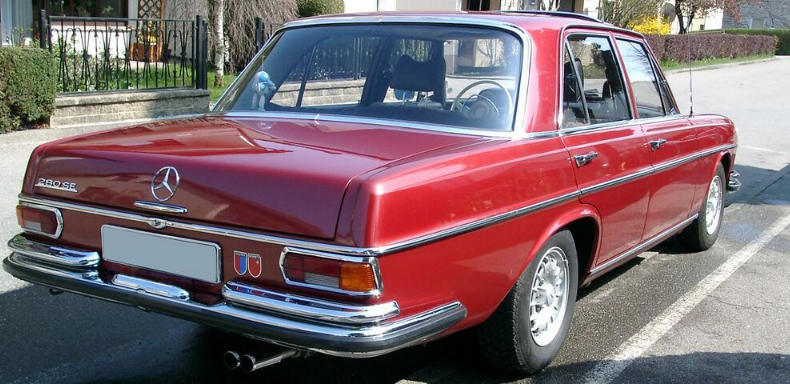
The car's predecessor, the Mercedes-Benz W111 (produced 1959–1971) helped Daimler develop greater sales and achieve economy of scale production. Whereas in the 1950s, Mercedes-Benz was producing the coachwork 300 S and 300 SLs and all but hand-built 300 Adenauers alongside conveyor assembled Pontons (190, 190SL and 220) etc., the fintail (German: Heckflosse) family united the entire Mercedes-Benz range of vehicles onto one automobile platform, reducing production time and costs. However, the design fashion of the early 1960s changed. For example, the tail fins, originally intended to improve aerodynamic stability, died out within a few years as a fashion accessory. By the time the 2-door coupe and cabriolet W111s were launched, the fins lost their chrome trim and sharp appearance, the arrival of the W113 Pagoda in 1963 saw them further buried into the trunk's contour, and finally disappeared on the W100 600 in 1964.
The upgrade of the W111 began under the leadership of designer Paul Bracq in 1961 and ended in 1963. Although the fins' departure was the most visible change, the W108 compared to the W111 had a lower body waist line that increased the window area, (the windscreen was 17 percent larger than W111). The cars had a lower ride (a decrease by 60 mm) and wider doors (+15 mm). The result was a visibly new car with a more sleek appearance and an open and spacious interior.[1]
The suspension system featured a reinforced rear axle with hydropneumatic compensating spring. The car sat on larger wheels (14”) and had disc brakes on front and rear. The W109 was identical to the W108, but featured an extended wheelbase of 115 mm (4.5 in) and self-levelling air suspension. This was seen as a successor to the W112 300SEL that was originally intended as an interim car between the 300 "Adenauer" (W189) and the 600 (W100) limousines. However, its success as "premium flagship" convinced Daimler to add an LWB car to the model range. From that moment on, all future S-Class models would feature a LWB line.
Although the W108 succeeded the W111 as a premium range full-size car, it did not replace it. Production of the W111 continued, however the 230S was now downgraded to the mid-range series, the Mercedes-Benz W110, and marketed as a flagship of that family until their production ceased in 1968. The W108 is popular with collectors and the most desirable models to collect are the early floor shift models with the classic round gear knob and the 300 SEL's.
2. Initial Range
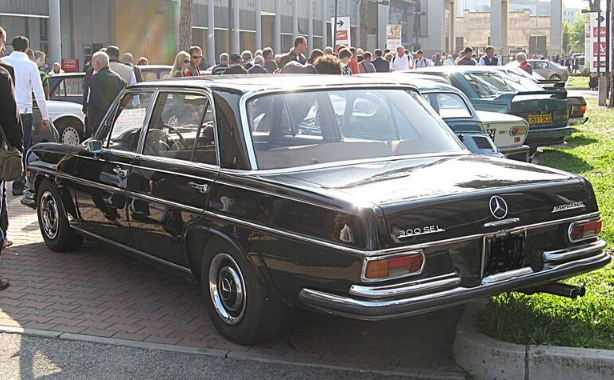
The car was premièred at the Frankfurt Auto Show in 1965. The initial model lineup consisted of three W108s: 250S, 250SE, and 300SE, as well as a sole W109, the 300SEL. Engines for the new car were carried over from the previous generation, but enlarged and refined.
The 250S was the entry-level vehicle fitted with a 2496 cm³ Straight-six M108 engine, with two dual downdraft carburettors, delivering 130 bhp (97 kW) at 5400 rpm which accelerated the car to 100 km/h (62 mph) in 13 seconds (14 on automatic transmission) and gave a top speed of 182 km/h (177 on auto).
The 250SE featured an identical straight-six, but with a six-plunger fuel injection (designated M129) with performance improved to 150 bhp (110 kW) at 5500 rpm, which decreased 0-100 acceleration by one second and increased top speed by 11 km/h (7 mph) for both manual and automatic versions.
Both the 300SE and 300SEL came with the M189 2996 cm³ engine, originally developed for the Adenauers. It had a modern six-plunger pump that adjusted automatically to accelerator pedal pressure, engine speed, atmospheric pressure, and cooling water temperature, to deliver the proper mixture depending on driving conditions. Producing 170 bhp (130 kW) at 5,400 rpm the cars could accelerate to 200 km/h (195 km/h with automatic transmission) and reach 100 km/h (62 mph) in 12 seconds. The cylinder capacity of the three litre Mercedes engine was unchanged since 1951. From 1965 to 1967, fewer than 3,000 W109s were produced. However, approximately 130,000 of the less powerful 250 S/SE models were built during the first two years of the W108/109's existence. By 1967 the fuel consumption of the 3 litre unit in this application was becoming increasingly uncompetitive.
3. New Generation

During the winter of 1967/1968 Daimler launched its new generation family of vehicles, called Stroke eight for the model year. The headline was the new W114 and W115 family, built on a new chassis, but the existing models were given an upgrade with a single engine, the 2778 cc M130.
The W108 now included 280S and 280SE, with production starting in November 1967. These replaced the 250S, 250SE and 300SE, however production of export-designated 250S would continue until March 1969. For the W109, the 300SEL finally retired the M189 engine, and received the 280Se's 2.8 M130. In January 1968, the model line was joined by yet another car, the 280SEL. The car had the longer wheelbase of the W109, but lacked the pneumatic suspension and other features of the 300SEL. Hence the chassis code remained W108.
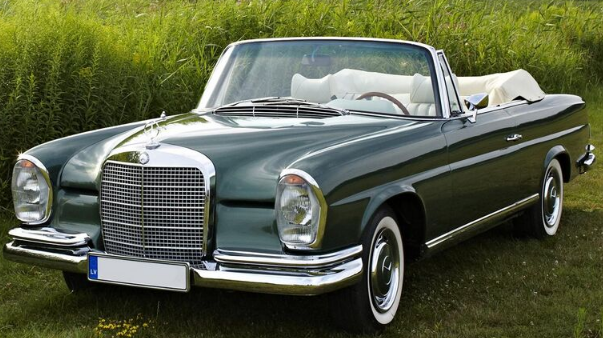
Performance on the cars improved. On the 280S the two downdraft carburettors produced 140 hp (100 kW) and could push the car to 185 km/h (180 on auto), whilst 0-100 was done in 12.5 seconds. The fuel-injected delivered 160 hp (120 kW), and featured a new pump which was not affected by temperature or altitude. Thanks to the air oil filter and better arrangement of cylinders, cooling and hence economy improved. Performance of the 280SE, 280SEL and 300SEL was all but identical, a top speed of 190 km/h (185 on auto) and a 0-100 acceleration in 10.5 seconds for the W108s, the W109 due to its larger weight, took slightly longer, 12.2 seconds.
4. 6.3
Back in 1964, Mercedes-Benz launched its top-range W100 limousine which featured an OHC 6.3 litre V8 engine. However the hand-assembly of the limousine and its very high price limited the sale of the car, whilst the size and weight affected performance. In 1966 company engineer Erich Waxenberger transplanted a big V8 into a standard W109, creating the first Mercedes-Benz muscle car and Q-car.
Despite the large size of the W109, the automaker claimed 0-62 mph (0–100 km/h) time of 6.6 seconds. Full-scale production began in December 1967. Claimed as the fastest production sedan (top speed of 220 km/h), the 300SEL 6.3, held this title for many years. West Germany's stringently applied trade description laws and figures resulted in these figures being under quoted. The 6.3 also introduced a new numbering scheme, whereby the model name described the parent model and the engine displacement was separate. This nomenclature was used by Mercedes-Benz until the introduction of the class system in 1993.
5. Later Models
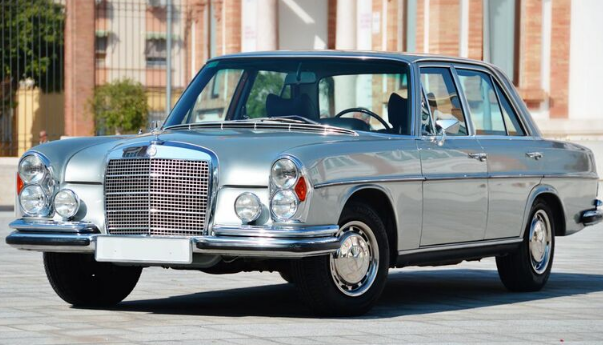
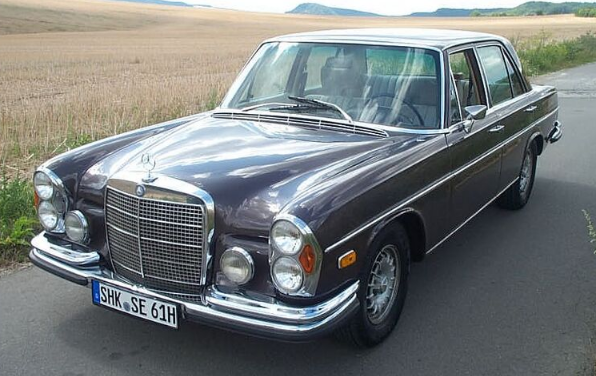
The 300SEL 6.3 was a special model and production of the fuel-thirsty M100 engines was limited. As new models were being developed the export markets had to be considered, and the United States in particular. The American car production by the late 1960s has largely switched to V8 powered cars, and Mercedes-Benz had to produce its own eight-cylinder engine to stay competitive.
The new engines arrived in late 1969. The first was the 200 hp (150 kW) M116 3499 cc V8 with Bosch D-Jetronic electronic fuel injection, and was shown fitted to the W109 on the Frankfurt Auto Show. The car was christened the 300SEL 3.5. Its performance included a top speed of 200 km/h (124 mph) and 0–100 km/h in 10 seconds. During summer of 1970, the M116 was added to the W108 lineup on both regular and LWB, the 280SE 3.5 and the 280SEL 3.5 respectively.
The next year saw the 2-door W111s and the W113 Pagoda roadsters being phased out of production. This left the W108 and W109 as the sole survivors of the ageing family. However the arrival of the big-block 4520 cc 225 hp (168 kW) M117 engine allowed for a final set of vehicles to be launched in the spring of 1971, the W108 280SE 4.5 and 280SEL 4.5 and the W109 300SEL 4.5. This, was destined solely for the US market. Performance improved, top speed - 205 km/h, 0-100 - 9.5 seconds.
However, as the mainstream V8 models were being introduced, production was already drawing to a close. The straight-six 300SEL was finished in January 1970, and in April 1971 the 280SEL followed. The 280SE 3.5 and 280SEL W108s were retired in summer of 1972. In September the last 300SEL 3.5 and the 6.3 rolled off the conveyors. A month later, the final 300SEL 4.5 ended the W109's output, and in November saw the final models of the W108 280SE and 280SEL 4.5s end a seven-year history.
6. Legacy
Although many critics described the car as a "fintail without the fintails", the vehicle was an amazing success. Mostly, due its simple and square contours, it is not remembered for its looks, though some argue that it was thanks to such design that the car has such a timeless charm, but instead it was very well known for its reliability and durability, as proof of excellent German engineering. Last, but not least, the car ended nearly a full decade of the Ponton family (1953–1962), thanks to which, Mercedes-Benz went from a ruined post-WWII marque to one of European and World leaders in automotive industry. It was succeeded by the W116, a car which brought a new household name for any car, the S-class.
7. Improvements
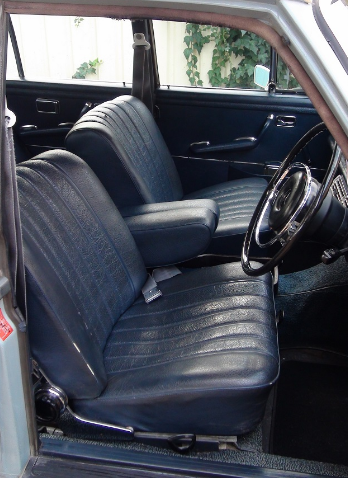
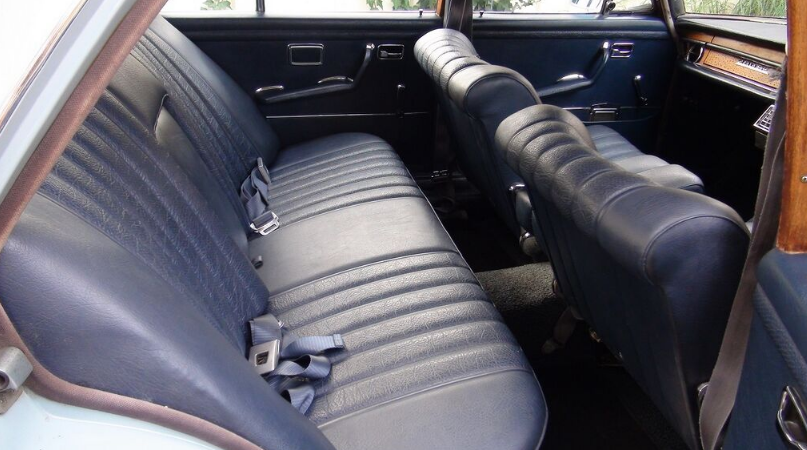
The W108/W109 vehicles carried over many of the basic engineering principles from previous models, but had many refinements to make them some of the most well equipped cars of the era. The 300SE and 300SEL were especially well-appointed, featuring burled walnut dashboards, automatic transmission and power windows. The 300SEL 4.5 featured a sophisticated and advanced 4.5L V8 petrol engine, which was carried over to the W116 S-class and R107 SL roadster, as was the smaller 3.5L unit.
8. Transmission
The standard transmission for Europe was a four-speed manual gearbox. A four-speed automatic option was also available. Unusual among mainstream European automakers of the time, Mercedes developed and built their own automatic transmission system.[2] For the six-cylinder models only, a five-speed manual gearbox was also offered, from 1969, though few customers opted for it.
When the V8-engined cars were introduced in 1970, the default transmission was the four-speed automatic, driven via a fluid coupling rather than the more usual torque converter. Buyers could still opt for a four-speed manual box, however, and benefitted from a price reduction if they did so. The 4.5 litre version (offered from 1971 but only in the United States ), was fitted with a three-speed automatic box with a torque converter. This engine/transmission combination became more widely available when incorporated in the successor model.
9. Models
9.1. W108
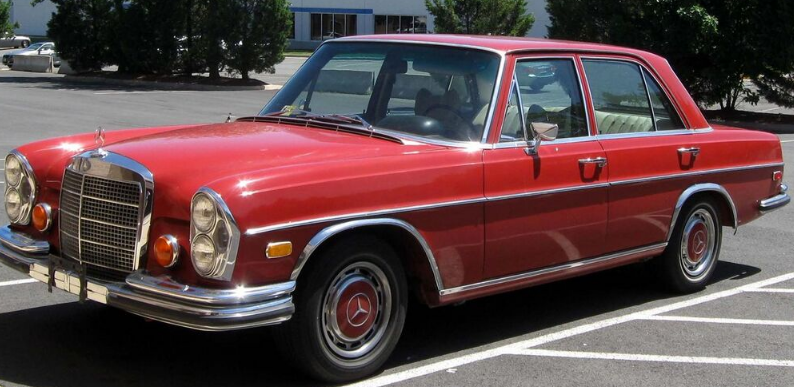
| Model | Chassis code | Production time | Number built | Engine |
|---|---|---|---|---|
| 250S | W108.012 | 07/65–03/69 | 74,677 | 2.5 L M108 I6 |
| 250SE | W108.014 | 08/65–01/68 | 55,181 | 2.5 L M129 I6 |
| 300SEb | W108.015 | 08/65–12/67 | 2,737 | 3.0 L M189 I6 |
| 280S | W108.016 | 11/67–09/72 | 93,666 | 2.8 L M130 I6 |
| 280SE | W108.018 | 11/67–09/72 | 91,051 | 2.8 L M130 I6 |
| 280SEL | W108.019 | 01/68–04/71 | 8,250 | 2.8 L M130 I6 |
| 280SE 3.5 | W108.057 | 07/70–09/72 | 11,309 | 3.5 L M116 V8 |
| 280SEL 3.5 | W108.058 | 06/70–08/72 | 951 | 3.5 L M116 V8 |
| 280SE 4.5 | W108.067 | 04/71–11/72 | 13,527 | 4.5 L M117 V8 |
| 280SEL 4.5 | W108.068 | 05/71–11/72 | 8,173 | 4.5 L M117 V8 |
9.2. W109
| Model | Chassis code | Production time | Number built | Engine |
|---|---|---|---|---|
| 300SEL | W109.015 | 09/65–12/67 | 2,369 | 3.0 L M189 I6 |
| 300SEL | W109.016 | 12/67–01/70 | 2,519 | 2.8 L M130 I6 |
| 300SEL 6.3 | W109.018 | 12/67–09/72 | 6,526 | 6.3 L M100 V8 |
| 300SEL 3.5 | W109.056 | 08/69–09/72 | 9,483 | 3.5 L M116 V8 |
| 300SEL 4.5 | W109.057 | 05/71–10/72 | 2,533 | 4.5 L M117 V8 |
9.3. Timeline
| Type | Chassis | 1965 | 1966 | 1967 | 1968 | 1969 | 1970 | 1971 | 1972 |
| Sedan | W108 | 250S | |||||||
| 250SE | |||||||||
| 280S | |||||||||
| 280SE | |||||||||
| 280SEL | |||||||||
| 300SEb | |||||||||
| 280SE 3.5 | |||||||||
| 280SEL 3.5 | |||||||||
| 280SE 4.5 | |||||||||
| 280SEL 4.5 | |||||||||
| W109 | 300SEL | ||||||||
| 300SEL 3.5 | |||||||||
| 300SEL 4.5 | |||||||||
| 300SEL 6.3 | |||||||||
10. Technical Info
| Mercedes-Benz | 250 S (W108 II) |
250 SE (W108 III) |
300 SE (W108 IV) |
280 S (W108 V28) |
280 SE (W108 E28) |
280 SEL (W108 E28) |
280 SE 3.5 (W108 E35)† |
|---|---|---|---|---|---|---|---|
| Chassis code: | W108.012 | W108.014 | W108.015 | W108.016 | W108.018 | W108.019 | W108.057 |
| Produced: | 07/65 – 03/69 | 08/65 – 01/68 | 08/65 – 12/67 | 11/67 – 09/72 | 01/68 – 04/71 | 07/70 – 09/72 | |
| Units: | 74,677 |
55,181 |
2,737 (includes 300 SEL) |
93,666 | 91,051 | 8,250 | 11,309 |
| Engine: | 2497 cc M108 I6 | 2497 cc M129 I6 | 2996 cc M189 I6 | 2778 cc M130 I6 | 3499 cc M116 V8 | ||
| Bore x Stroke: | 82 mm (3.2 in) x 78.8 mm (3.1 in) | 85 mm (3.3 in) x 88 mm (3.5 in) | 86.5 mm (3.4 in) x 78.8 mm (3.1 in) | 92 mm (3.6 in) x 65.8 mm (2.6 in) | |||
| Max. Power @ rpm: | 130 PS (96 kW; 130 hp) @ 5400 | 150 PS (110 kW; 150 hp) @ 5500 | 170 PS (130 kW; 170 hp) @ 5400 | 140 PS (100 kW; 140 hp) @ 4200 | 160 PS (120 kW; 160 hp) @ 5500 | 160 PS (120 kW; 160 hp) @ 5500 | 200 PS (150 kW; 200 hp) @ 5800 |
| Max. Torque @ rpm: | 194 N⋅m (143 lb⋅ft) @ 4000 | 216 N⋅m (159 lb⋅ft) @ 4200 | 250 N⋅m (180 lb⋅ft) @ 4000 | 223 N⋅m (164 lb⋅ft) @ 3600 | 240 N⋅m (180 lb⋅ft) @ 4250 | 240 N⋅m (180 lb⋅ft) @ 4250 | 286 N⋅m (211 lb⋅ft) @ 4000 |
| Compression Ratio: | 9.0: 1 | 9.5: 1 | 8.8: 1 | 9.0: 1 | 9.5: 1 | 9.5: 1 | 9.5: 1 |
| Fuel feed: | Two 2-bbl Zenith 35/40 | Mechanical Bosch injection | Two 2-bbl Zenith 35/40 | Mechanical Bosch injection | Bosch D-Jetronic | ||
| Fuel tank capacity: | 82 L (21.7 US gal; 18.0 imp gal) | ||||||
| Valvetrain: | SOHC, duplex chain | SOHC, duplex chain | SOHC, duplex chain | ||||
| Cooling: | Water | ||||||
| Gearbox: | 4-speed manual w/ column or floor shifter or 4-speed automatic rear wheel drive, standard axle ratio 3.92:1 or 3.69:1 (V8: 3.46:1) |
||||||
| Electrical system: | 12 volt | ||||||
| Front suspension: | Double wishbones, coil springs, stabilising bar | ||||||
| Rear suspension:: | Low-pivot swing axle, radius arms, coil springs | ||||||
| Brakes: | Disc brakes (Ø 273 mm (10.7 in) front, 279 mm (11.0 in) rear), power assisted | ||||||
| Steering: | Recirculating ball steering, manual or servo-assisted | ||||||
| Body structure: | Sheet steel, monocoque (unibody) construction | ||||||
| Dry weight: | 1,470 kg (3,240 lb) | 1,510 kg (3,330 lb) | 1,575 kg (3,472 lb) | 1,520 kg (3,350 lb) | 1,560 kg (3,440 lb) | 1,575 kg (3,472 lb) | 1,610 kg (3,550 lb) |
| Loaded weight: | 1,940 kg (4,280 lb) | 1,980 kg (4,370 lb) | 2,060 kg (4,540 lb) | 1,960 kg (4,320 lb) | 1,985 kg (4,376 lb) | 2,000 kg (4,400 lb) | 2,055 kg (4,530 lb) |
| Track front/ rear: |
1,482 mm (58.3 in) / 1,485 mm (58.5 in) | ||||||
| Wheelbase: | S/SE: 2,750 mm (108 in) SEL: 2,850 mm (112 in) |
||||||
| Length: | S/SE: 4,900 mm (190 in) SEL: 5,000 mm (200 in) |
||||||
| Width: | 1,810 mm (71 in) | ||||||
| Height: | 1,440 mm (57 in) | ||||||
| Tyre/Tire sizes: | 7.35 H 14 or 185 HR 14 | 185 VR 14 | |||||
| Top speed: | 182 km/h (113 mph) | 193 km/h (120 mph) | 200 km/h (120 mph) | 185 km/h (115 mph) | 193 km/h (120 mph) | 190 km/h (120 mph) | 210 km/h (130 mph) |
| Fuel Consumption (estimate): | 15.5 litres per 100 kilometres (18.2 mpg‑imp; 15.2 mpg‑US) | 18.0 litres per 100 kilometres (15.7 mpg‑imp; 13.1 mpg‑US) | 10.5 litres per 100 kilometres (27 mpg‑imp; 22 mpg‑US) | 11 litres per 100 kilometres (26 mpg‑imp; 21 mpg‑US) | 18.5 litres per 100 kilometres (15.3 mpg‑imp; 12.7 mpg‑US) | ||
| Price Germany USA: |
DM 15,300 $5,747 [4] |
DM 16,850 $6,385 |
DM 21,500 $8,048 |
DM 17,000 $5,897 |
DM 18,600 $6,222 |
DM n.a. $6,622 |
DM 24,920 $10,076 |
| Notes: | † North American version (280 SE/SEL 4.5: approx 22,000 units) with 4.5 liter V8, 195 hp/278 lb ft | ||||||
| Mercedes-Benz | 300 SEL (W109 III) | 300 SEL (W109 E28) | 300 SEL 3.5 (W109 E35/1)† | 300 SEL 4.5 (W109 E45) | 300 SEL 6.3 (W109 E63) | ||
|---|---|---|---|---|---|---|---|
| Chassis code | W109.015 | W109.016 | W109.056 | W109.057 | W109.018 | ||
| Produced: | 09/65 – 12/67 | 12/67 – 01/70 | 08/69 – 09/72 | 05/71 – 10/72 | 12/67 – 09/72 | ||
| Units: | 2,369 | 2,519 | 9,483 | 2,533 | 6,526 | ||
| Engine: | 2996 cc M189 I6 | 2778 cc M130 I6 | 3499 cc M116 V8 | 4520 cc M117 V8 | 6333 cc M100 V8 | ||
| Bore x Stroke: | 85 mm (3.3 in) x 88 mm (3.5 in) | 86.5 mm (3.4 in) x 78.8 mm (3.1 in) | 92 mm (3.6 in) x 65.8 mm (2.6 in) | 92 mm (3.6 in) x 85 mm (3.3 in) | 103 mm (4.1 in) x 95 mm (3.7 in) | ||
| Max. Power @ rpm: | 170 PS (130 kW; 170 hp) @ 5400 | 170 PS (130 kW; 170 hp) @ 5750 | 200 PS (150 kW; 200 hp) @ 5800 | 198 PS (146 kW; 195 hp) @ 4500 | 250 PS (180 kW; 250 hp) @ 4000 | ||
| Max. Torque @ rpm: | 250 N⋅m (180 lb⋅ft) @ 4000 | 240 N⋅m (180 lb⋅ft) @ 4500 | 286 N⋅m (211 lb⋅ft) @ 4000 | 358 N⋅m (264 lb⋅ft) @ 3000 | 500 N⋅m (370 lb⋅ft) @ 2800 | ||
| Compression Ratio: | 8.8: 1 | 9.5: 1 | 9.5: 1 | 8.0: 1 | 9.0: 1 | ||
| Fuel feed: | Mechanical Bosch injection | Bosch D-Jetronic | Mechanical Bosch injection | ||||
| Fuel tank capacity: | 82 L (21.7 US gal; 18.0 imp gal) | 105 L (27.7 US gal; 23.1 imp gal) | |||||
| Valvetrain: | SOHC, duplex chain | ||||||
| Cooling: | Water | ||||||
| Gearbox: | 4-speed manual w/ column or floor shifter or 4-speed automatic rear wheel drive, standard axle ratio 3.92:1 or 3.69:1 (V8: 3.46:1) |
3-speed automatic rear wheel drive, standard axle ratio 3.23:1 |
4-speed automatic rear wheel drive, standard axle ratio 2.85:1 |
||||
| Electrical system: | 12 volt | ||||||
| Front suspension: | Double wishbones, air springs, rubber springs, stabilising bar | ||||||
| Rear suspension:: | Swing axle, radius arms, air and additional rubber springs | ||||||
| Brakes: | Disc brakes (Ø 273 mm (10.7 in) front, 279 mm (11.0 in) rear), power assisted | ||||||
| Steering: | Recirculating ball steering, servo-assisted | ||||||
| Body structure: | Sheet steel, monocoque (unibody) construction | ||||||
| Dry weight: | 1,655 kg (3,649 lb) | 1,695 kg (3,737 lb) | 1,730 kg (3,810 lb) | 1,759 kg (3,878 lb) | 1,830 kg (4,030 lb) | ||
| Loaded weight: | 2,140 kg (4,720 lb) | 2,120 kg (4,670 lb) | 2,170 kg (4,780 lb) | 2,222 kg (4,899 lb) | 2,265 kg (4,993 lb) | ||
| Track front/ rear: |
1,482 mm (58.3 in) 1,485 mm (58.5 in) |
1,482 mm (58.3 in) 1,490 mm (58.7 in) |
|||||
| Wheelbase: | 2,850 mm (112.2 in) | ||||||
| Length: | 5,000 mm (196.9 in) | ||||||
| Width: | 1,810 mm (71.3 in) | ||||||
| Height: | 1,440 mm (56.7 in) | 1,470 mm (58 in) | |||||
| Tyre/Tire sizes: | 185 HR 14 | 185 VR 14 | 195 VR 14 or
(205/70 VR 14) |
||||
| Top speed: | 200 km/h (120 mph) | 195 km/h (121 mph) | 200 km/h (120 mph) | 205 km/h (127 mph) | 221 km/h (137 mph) | ||
| Fuel Consumption (estimate): | 18.0 litres per 100 kilometres (15.7 mpg‑imp; 13.1 mpg‑US) | 16.5 litres per 100 kilometres (17.1 mpg‑imp; 14.3 mpg‑US) | 18.5 litres per 100 kilometres (15.3 mpg‑imp; 12.7 mpg‑US) | 16.3 litres per 100 kilometres (17.3 mpg‑imp; 14.4 mpg‑US) | 21.0 litres per 100 kilometres (13.5 mpg‑imp; 11.2 mpg‑US) | ||
| Price Germany USA: |
DM 28,600 $9,910 [4] |
DM n.a. $9,400 |
DM 31,025 $11,327 |
DM 31,025 $11,327 |
DM 39,160 $15,122 |
||
| Notes: | † North American version (300 SE/SEL 4.5: approx 2,500 units) with 4.5 liter V8, 195 hp/278 lb ft (MY 1972) | ||||||
11. Trivia
A batch of Mercedes-Benz W108 were used by Soviet State Automobile Inspectorate (GAI) in militsiya livery in the 1970s in Moscow, first of all for escorting columns of automobiles.[5]
12. Film Appearances
A black 250SE was stolen by James Bond (Roger Moore) from comrades of General Orlov (Steven Berkoff) in East Germany in the 1983 feature film Octopussy. When its tires were punctured by a trap, Bond drove the car along a railway track in pursuit of a train carrying Octopussy's circus across the West/East German border (although the scenes were actually filmed in Cambridgeshire, England ), and just before reaching the border Bond managed to jump upon the train just before the car collided head-on with another train and was sent flying into a river.[6]
A 4.5 variant was used in the training montage scenes of Rocky 4.
In The Hangover the main characters drive a 1969 280SE convertible from Los Angeles to Las Vegas and trash the car. Apparently the convertibles used in the movie were modified coupes. 16 coupes were used; they were crashed multiple times. The 280 SE coupes and convertibles are actually designated W111 in Mercedes nomenclature.
A 280SE 4.5 is featured in the Netflix series Bates Motel owned by Norma Bates.
The content is sourced from: https://handwiki.org/wiki/Engineering:Mercedes-Benz_W108
References
- Bernd. "Mercedes 250S, SE W108: Mercedes elegance at its best". http://benz-books.com/blog/542/mercedes-250s-se-w108/. Retrieved 15 March 2015.
- Garnier, Peter, ed (2 February 1967). "Autocar Road Test: Mercedes-Benz 250 SE". Autocar 126 (3703): 17–23.
- Oswald, Werner (2001) (in German). Deutsche Autos 1945-1990, Band 4. Stuttgart: Motorbuch Verlag. ISBN 3-613-02131-5.
- Covello, Mike (2002). Standard Catalog of Imported Cars 1946-2002. Iola: Krause Publication. pp. 533–536. ISBN 0-87341-605-8.
- "Ford Crown Victoria DPS GAI" (in Russian). Avtomobil Na Sluzhbie (DeAgostini) (59): 4–5. 2014. ISSN 2223-0440. http://www.worldcat.org/issn/2223-0440
- "1968 Mercedes-Benz 280 S [W108 in "Octopussy, 1983""]. IMCDb.org. http://www.imcdb.org/vehicle_2379-Mercedes-Benz-280-S-W108-1968.html. Retrieved 1 February 2011.
